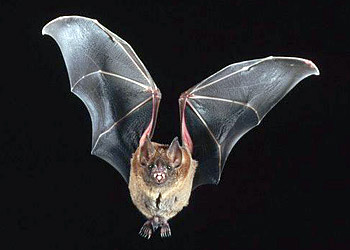Wrinkled-Lipped Bat (Tadarida plicata) {!--주름입박쥐--> Wrinkled-Lipped Bat
(Tadarida plicata)
Order: Chiroptera
Family: Chaerephon
I. DESCRIPTION:
The wrinkled-lipped bat has a relatively small skull, with an extra-small upper premolar. The upper part of its body is covered with short brown fur, and its underparts are paler with gray tips to the fur. Its upper lip is heavily wrinkled, and it has large, round, forward-pointing ears that are joined across the top of its head by a narrow flap of skin. This species has piglike nostrils.
Known as a free-tailed bat, the wrinkled-lipped bat is distinguished by a thick tail that protrudes from the membrane stretching between its legs.
The bat's wings are an evolutionary modification of the forelimbs.
II. GEOGRAPHICAL RANGE AND HABITAT:
Wrinkled-lipped bats inhabit Sri Lanka, India, southern China, Southeast Asia, the Philippines, and Indonesia's Sumatra and Java islands.
In Borneo, these bats form large cave roosts at Gomantong and Madai in Sabah, as well as Mulu and near Kuching in Sarawak.
They roost in caves in large, densely packed colonies, which sometimes contain hundreds (even thousands) of individuals.
III. DIET
Wrinkled-lipped bats eat insects, mostly moths, which they hunt in midair.
IV. LIFE CYCLE/SOCIAL STRUCTURE:
Most mating activity occurs over a period of a few weeks; females generally bear one offspring. Infants are often blind and deaf for a short period of time after birth.
Wrinkled-lipped bats may live as long as 20 years, due to their isolated roosts, nocturnal activity and colonial way of life.
V. SPECIAL NOTES/ADAPTATIONS:
Bats roost during the day and forage at night; they usually exit their caves before darkness falls in dense flocks. Night foraging protects them from predators, sun and high temperatures.
They hunt prey and navigate in the dark using echolocation.
They tend to nest near the entrance of caves.
The bat is the only mammal to have evolved true flight.
Bats rest, or roost, hanging upside down by their feet; the weight of the bat's body causes the foot tendons to grasp automatically, which keeps the animal in place.
VI. EFFECT ON HABITAT:
Bat guano and corpses serve as food for insects, thus contributing to the food chain.
The crested goshawk and Jerdon's baza (hawk) usually prey on wrinkled-lipped bats as they exit their caves in the evening.
Bats help maintain the balance of insect populations.
VII. POPULATION STATUS:
Some bat species are listed as endangered, and many of those that are not ??? including the wrinkled-lipped ??? are quickly becoming candidates.
Echolocation:
Echolocation is a series of short high-frequency sound pulses that reflect from objects in the vicinity. Bats listen to the returning echoes and are able to locate prey and obstacles. Highly sensitive ears and greatly developed integration of vocal and auditory centers of the brain are required for echolocation. Bats also use echolocation to communicate with one another.
Aboriginal Folk Tale:
When the first man and woman were placed on Earth, they were told to stay away from a large bat that guarded an entrance to a cave. Curious, the woman approached the bat, disturbing it from its perch. As a result, death was released from the cave, and since then humankind has died.
Photo & Text: Animal Planet :: Corwin's Carnival of Creatures http://animal.discovery.com/fansites/jeffcorwin/carnival/flyingace/wrinkledbat.html
